Cut to the chase
Best DIY Vinyl Floor Cleaners
- White Vinegar and Water- amazing general cleaner for floors.
- Baking Soda and Water – baking soda is alkaline so it helps cut acidic substances like tomato juice, body fluids, coffee and condiments.
- Lemon Juice– acidic and cuts rust, fruit juice, general yellowing.
- Rubbing Alcohol– awesome cutting power for grease, ink, sap, or grass.
- WD-40– also cuts grease, tar, lipstick and crayon.
- Specialty Vinyl Cleaner– if you want a store bought option, there are several like Bona, Simple Green or Rejuvenate.
- *Read on for mixing and use instructions.
Vinyl flooring is one of the most popular types of flooring today. It’s easy to install, low maintenance, and affordable. The options for vinyl floors are vast. There are vinyl flooring options for every budget, every type of décor, and every taste.
Although easy to clean, vinyl floors can fade over time. This could lead to yellow marks on the floor. Stains can also be caused by spills, dirt, and grime. So learning how to clean discolored vinyl flooring is crucial to keeping these floors looking their best.
Sometimes, the discoloration is not reversible, but there are six ways you can try to clean it before getting it replaced. Read more to find out how to clean discolored vinyl flooring.
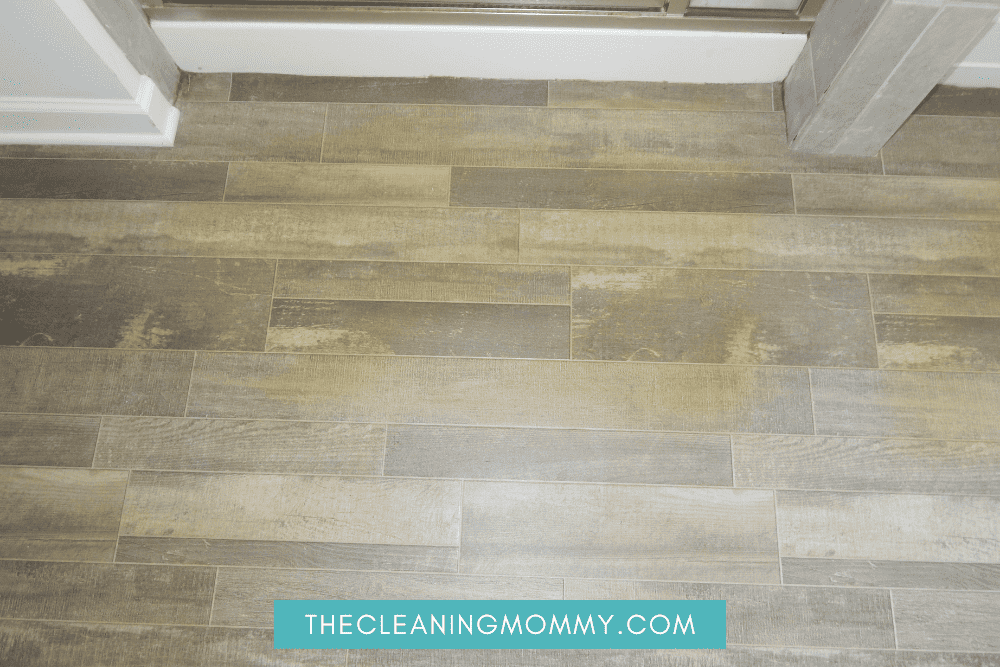
How To Clean Discolored Vinyl Flooring
Now, let’s learn how to clean discolored vinyl floors. These proven methods will have your floors look brand new and clean in no time.
#1 White Vinegar and Water
White vinegar is a fantastic general purpose cleaner. It has acidic properties which allows it to cut through most every day dirt and grime. It does smell a bit, but that goes away once it dries. We use white vinegar on our LVP floors every week.
- Mix one cup of distilled white vinegar into one gallon of hot water.
- Mop your floor as normal. If you have plank vinyl. make sure to wring out the mop well so that water does not pool.
- Allow the floor to air dry which will eliminate any vinegar odor.
#2 Baking Soda and Water
You probably already have baking soda in your cabinet, which is a natural vinyl floor cleaner. It is an alkaline so it is most effective on acidic stains like tomato juice, body fluids, coffee and condiments. To use baking soda to clean your floors or remove stains, follow these simple steps:
- Mix baking soda and water to form a thick paste.
- Rub the paste over your stubborn stains using a soft white microfiber cloth. Rub gently to avoid scratches. The abrasive nature of baking soda will aid in removing and lifting the stains.
- Baking soda residue should be removed by wiping it with a different, clean microfiber cloth.
#3 Lemon
Lemon juice contains citric acid, a non-toxic antiseptic and antibacterial agent found in many industrial products. Water stains, discoloration, and tea or coffee stains are all effectively removed by it.
- Simply cut the lemon in half and rub it directly on the stain. Rub gently. Use the other half of the lemon if the stain is being stubborn.
- Wipe the lemon juice resideue with a clean cloth.
- Dry it with a different clean cloth.
#4 Rubbing Alcohol
If the aforementioned techniques fail to get rid of yellow stains on your vinyl flooring, consider using rubbing alcohol. It will also work well on ink and makeup stains.
This technique has the major benefit of leaving no residue, which allows your vinyl flooring to dry quickly after treatment. It does not require rinsing to avoid film formation, unlike other cleaners.
Rubbing alcohol works especially well on greasy and oily stains and can be used to remove stains from ink and makeup.
- Before you start, ensure the surface has been cleared of dirt and other debris.
- Now, apply some rubbing alcohol (99% or 70% isopropyl alcohol) to the stained area.
- To make the stains fade, rub a towel against the spot in a circular motion.
- Add more rubbing alcohol to the area and continue rubbing if you don’t see a significant change in color.
- Use a dry cloth or mop to pat the flooring dry.
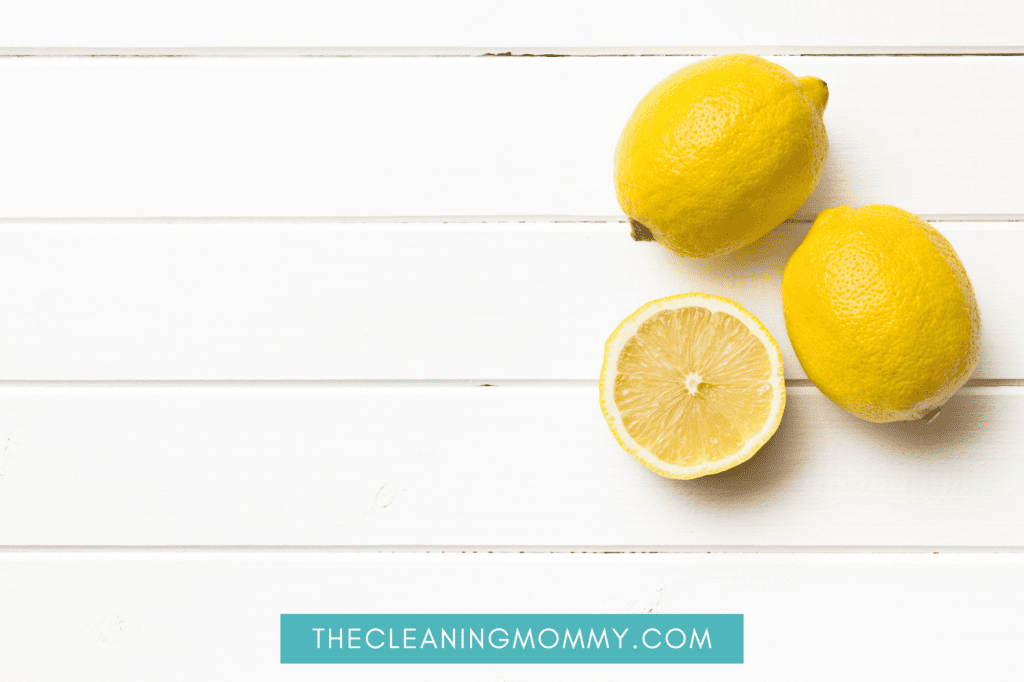
#5 Dish Soap And Apple Cider Vinegar
Though a mixture of water and dish soap can work wonders on its own, something a little stronger might be needed for more stubborn stains.
In these cases, you can try using a mixture of dish soap and apple cider vinegar for deep cleaning.
Apple cider vinegar is a gentle floor cleaner that will not only clean discolored vinyl floor but also remove vinyl flooring discoloration for good.
To clean stubborn stains on your floor:
- Add one cup of apple cider vinegar to a gallon of water.
- Add one tablespoon of dish soap to the mixture to lift the dirt.
- Use a mop to apply the cleaning solution to the floor and wipe it clean.
- If the stains still persist, you can use a soft, bristled brush to gently scrub the floor clean.
- After that, thoroughly dry the floor.
#6 WD-40
Scuff marks can be easily removed using WD-40. Also tar, grease, lipstick and crayon. Before applying the product to the entire stain, first, conduct a test by applying it to a small area of the stain and see how it reacts.
If it doesn’t cause damage and the stain is lifted, then proceed with the following steps.
- Add some WD-40 to the stain using a soft clean cloth.
- Gently rub the marks with the clean damp cloth in circular motions until you see them dissipate.
- If the scratch marks are not removed with this method, you can try using some of the other methods. If that does not work, it might be a permanent stain.
#7 Specialty Vinyl Floor Cleaner
We suggest Rejuvenate Vinyl Floor Cleaner if you’d prefer to use a product made exclusively for vinyl floors. The dirt, grime, and stains from harsh chemicals are removed with this non-toxic cleanser.
- Spray the cleaner onto the floors.
- Mop as normal.
- Let the floor dry or use a soft cloth to dry it.
Although water-resistant, vinyl flooring is not waterproof. So, discolored stains can result from moisture that develops on top of or beneath the tiles. If the tile is exposed to moisture for long periods of time, it might stain.
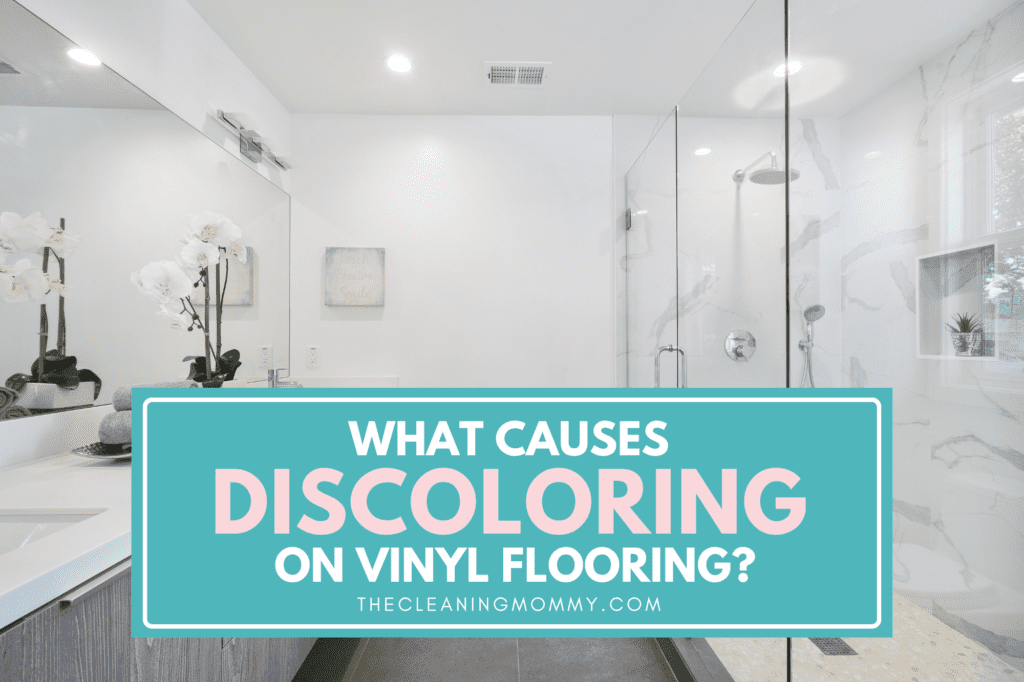
What Causes Discolored Vinyl Flooring?
Despite the flooring’s protective coating, most people think of stains on vinyl floors as being caused by spilled food or years of filth and grime.
Vinyl flooring can, however, also turn discolored from the bottom up or from underneath.
Here’s a list of the most frequent causes of vinyl floor discoloration:
#1 Adhesive Stains
The adhesive beneath the tiles is seeping through, causing unsightly stains on the floors. When you apply adhesive incorrectly or when you use the wrong adhesive– other than that recommended by the manufacturer to apply the vinyl, there may be some discoloration on the bottom layers.
#2 Mold and Mildew
Under vinyl floors and baseboards are the best place for mold and mildew since they thrive in moist environments. The vinyl flooring can quickly get stained by mold and mildew, necessitating decontamination and replacement for a mold-free house.
#3 Exposure to Sunlight
The UV rays of sunlight can have a bleaching effect on all types of materials, and vinyl floors are no exception. Avoid direct sunlight on your vinyl tiles to protect their longevity and preserve their original color. Consider rugs near patio doors that get direct sunlight.
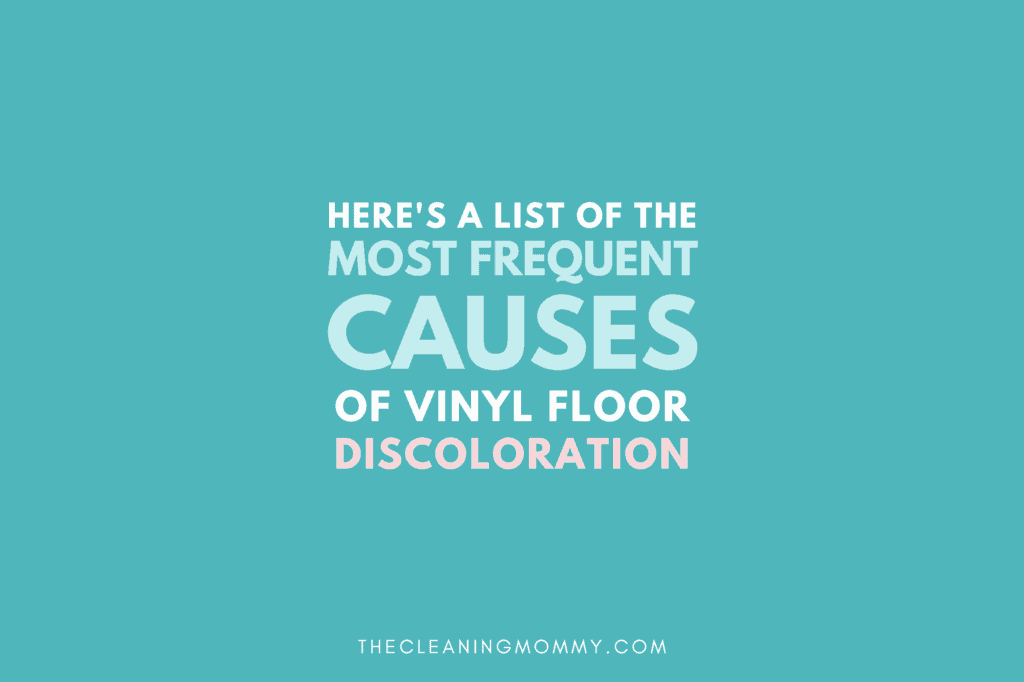
#4 Liquids
Liquid spills, such as those from milk, juice, and water, can leave stains on vinyl flooring. Sugary drinks are more difficult to clean up once they’ve dried, and water can discolor if left sitting for too long. Clean up spills as soon as possible.
#5 Food
Many food types can leave behind some prominent stains, especially foods that are known to be highly pigmented and stain-prone. It’s important to clean up any food spills as quickly as possible to avoid any staining.
#6 Makeup
Makeup is very pigmented and can leave permanent stains if not cleaned immediately. This is especially true for sticky lipstick stains and concealer.
#7 Crayons and Markers
Like makeup, crayons, and markers can leave stains that are tough to clean. It’s best to clean crayon scuffs and marker stains as quickly as possible.
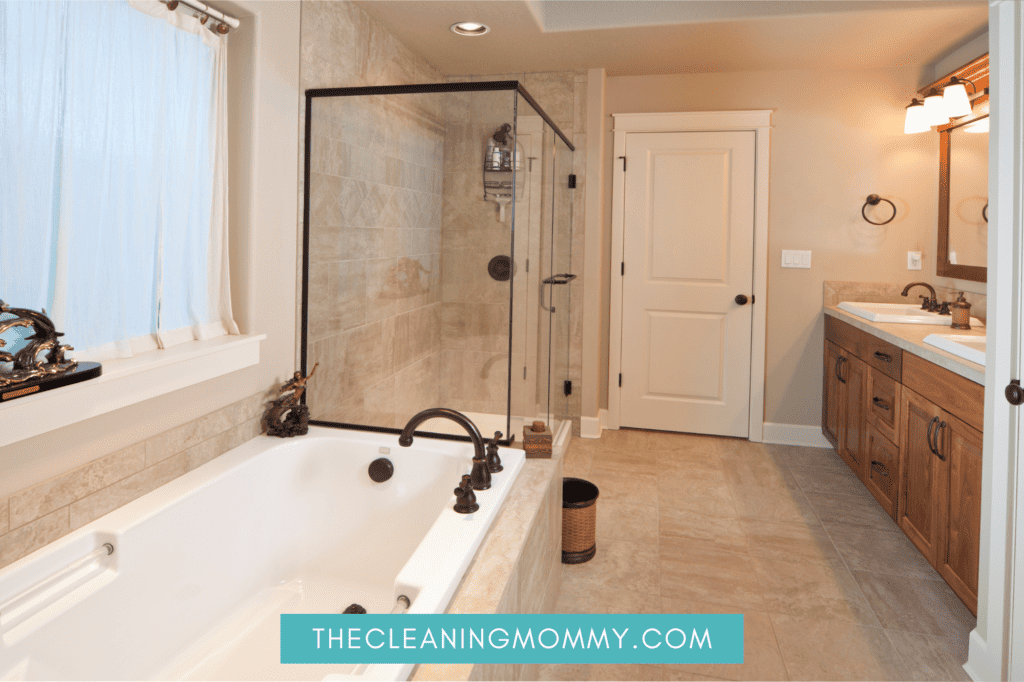
What Causes Yellow Stains on Vinyl Flooring?
After a few years, a yellow discoloration is to be expected because vinyl flooring fades over time. But if you keep the flooring clean, this shouldn’t be a problem.
Here are the key things you should avoid in order to prevent yellow spots & discolored vinyl flooring:
1. Keep dirt away
Each home is susceptible to dirt. Discoloration may result from the dirt and dust that have accumulated on the floor over time. Before stepping onto vinyl flooring, remember to remove your shoes. The dirt, gravel, and chemicals often found on asphalt can be abrasive to vinyl and, over time, result in discoloration
2. Avoid bleach and harsh chemicals
Avoid using any harsh chemicals like bleach to remove any stains on your vinyl floors, as bleach itself could lead to discoloration or yellow spots.
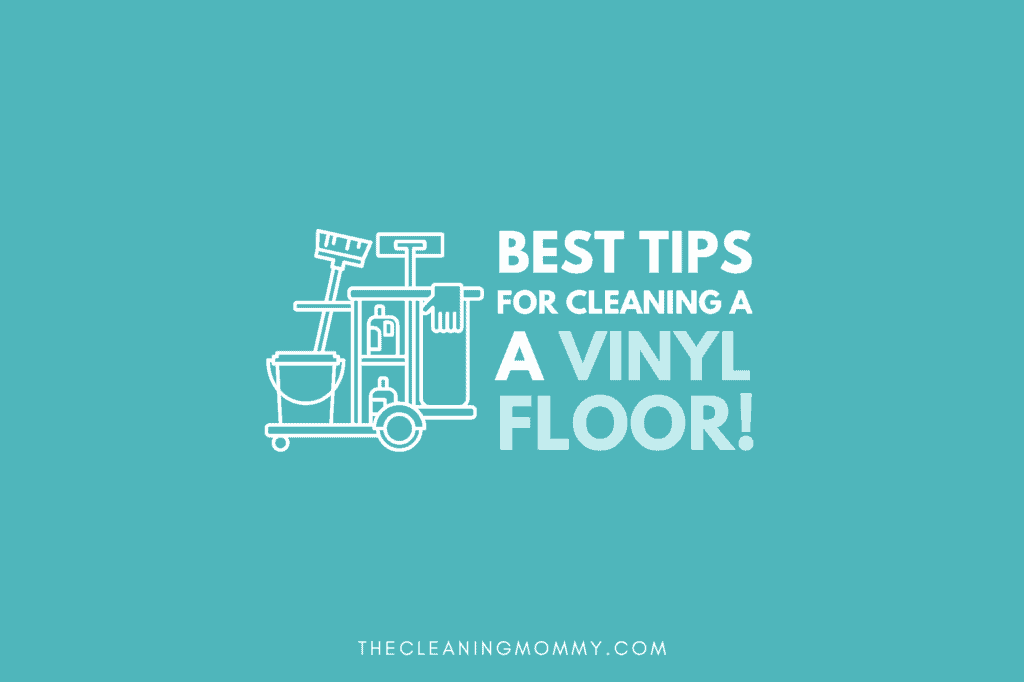
3. Avoid Heat
Don’t use steam cleaners, or the use of hot water for cleaning your vinyl floor.
4. Do not use rubber backed rugs
Who knew!!!!!! I did not know that these type of tugs should NOT be used on a vinyl floor, and now mine is discolored!!
Non-slip rubber materials on the back of rugs can damage the color of the vinyl tile by agitating the floor. The rubber causes a chemical reaction with vinyl which causes permanent discoloration.
I did this in my new house
If you have yellowing under your rubber mats, there may be nothing you can do.
5. Direct Sunlight
Vinyl flooring might not be the greatest option for you if your home has large windows or receives a lot of harsh light. It might be best to consider other flooring options that will perform better in these conditions.
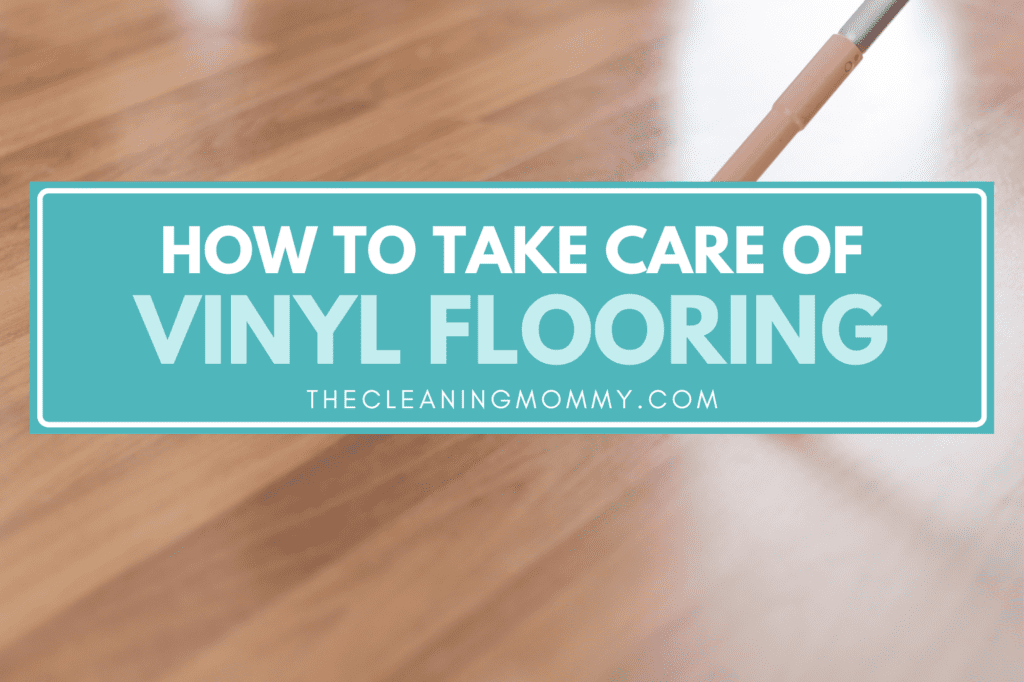
How to Care for Vinyl Flooring
To properly take care of your vinyl flooring, I recommend you do the following:
- Sweep daily: If you can spare a minute each day to sweep the floor, it will maintain its appearance for an extended period. The more dirt that accumulates on the floors, the greater the likelihood of scuff marks and discoloration. Use a soft bristled broom for daily sweeping.
- Vacuum Weekly: If at all possible, vacuum your floors on a weekly basis, but look for a vinyl vacuum as opposed to the one you use for your carpets.
- Mop Less Frequently: I bet you loved reading this vinyl flooring tip. Vinyl floors, although water-resistant, are not waterproof. You want to avoid adding unnecessary moisture to the vinyl planks to avoid any damage brought on by moisture. Only mop when it’s necessary, and then dry the floors properly after you mop.
- Don’t use a steam mop: Using intense heat can cause warping and bending in your vinyl floors.
- Preserve the finish: Only use cleaners that are specifically designed to clean vinyl floors. We recommend the Rejuvenate Vinyl Floor Cleaner.
- Avoid using harsh chemicals to clean the vinyl. This includes bleach or any cleaner with an ammonia base. Use a mild, more gentle cleaning solution for your winyl floor.
- Rinse after cleaning: After you use a cleaning solution on your finyl floor, rinse thoroughly so you don’t leave any residue behind and dry it well.
- High traffic areas: Use area rugs in high-traffic areas to protect your vinyl floor.
- Use floor protectors or felt pads: To prevent long-term floor indentation from furniture legs, heavy furniture and appliances should stand atop non-staining large surface floor protectors.
- Avoid using abrasive scours: Steer clear of abrasive cleaners when caring for your vinyl floors. Instead, opt for a soft cloth or a damp mop to clean them without risking damage to the finish. Abrasive cleaners have the potential to leave unsightly scratches on your floor.
- Avoid rubber mats like the plague: Avoid using rubber protective feet or rugs with rubber bottoms on your vinyl floors, as they have the potential to cause yellow discoloration
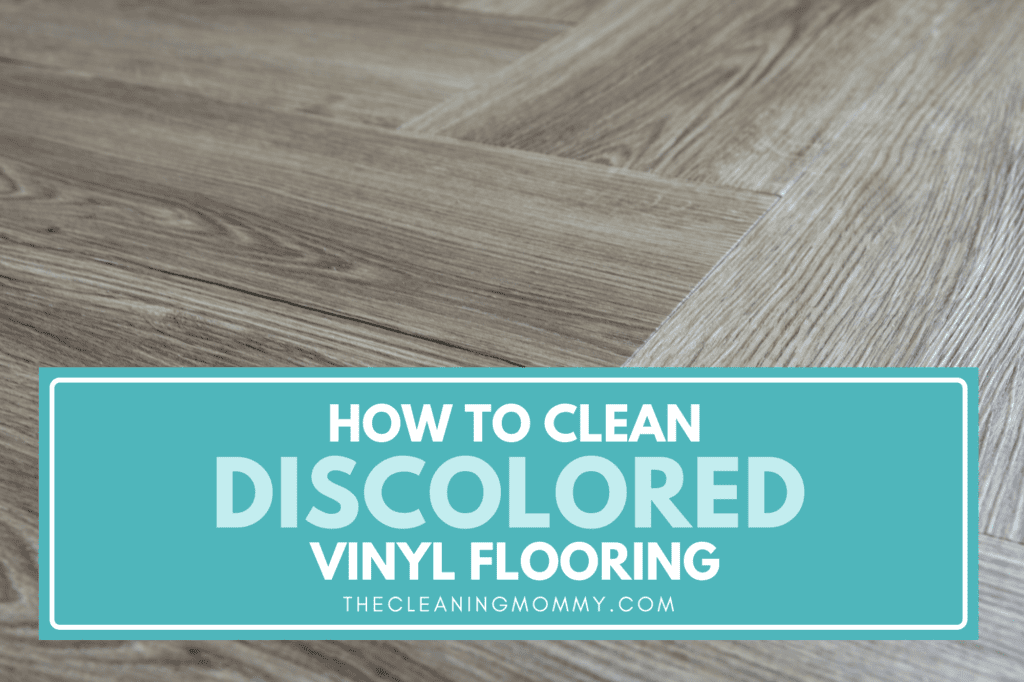
What Is Vinyl Flooring Made Of?
Vinyl flooring is a durable, inexpensive, and versatile tile that is also easy to clean. Vinyl flooring is created from polyvinyl chloride (PVC), to which several additives are added to customize the material’s properties, including color, flexibility, hardness, and gloss.
Simple vinyl sheets are the main component of vinyl flooring. The vinyl is suspended in a liquid during production to create a mixture that may be rolled into a thin layer and applied.
From here, the plastisol, or liquid plastic, coat is dried using heat and air, fusing the material to create a strong, long-lasting sheet. These sheets are then cut into square tiles and used to tile household floors.
How to Clean Discolored Viny Flooring Summary
Although vinyl flooring is not expensive, it’s still important to take care of it. Follow the guidelines above and you will enjoy your vinly floors for a long time. Ie hope this article has proven helpful with all the information that you need to properly care for and clean your vinyl floors.
In case I haven’t mentioned it often enough, don’t use rubber bottom rugs on your vinly floor!
If you apply the tip and tricks that we’ve shared, your floors will look fresh and clean for years to come.
Other Cleaning Articles You May Like:
- Cleaning Hacks To Clean Linoleum Floors With Ground In Dirt
- How to Clean Bamboo Floors Without Streaks
- How To Clean Unsealed Concrete Floors
- How to remove musty smells on your clothes
- How to mop a floor
- Best vacuum to use for a vinyl floor
- Cleaning hacks to clean linoleum floors with ground in dirt
- Best floor wax
- How to get stains out of hardwood floors
- How to remove oil stains from concrete
- How to get pee smells out of your home with these proven methods

Grainne Foley
Grainne Foley is a wife and mother of 2 great kids. During her 5 years of full time RV travel, Grainne learned to become very efficient at household chores, in order to make time for family adventures. Now, back in a house, she has continued to create tools and techniques to help others lighten the load of household organization and cleaning.
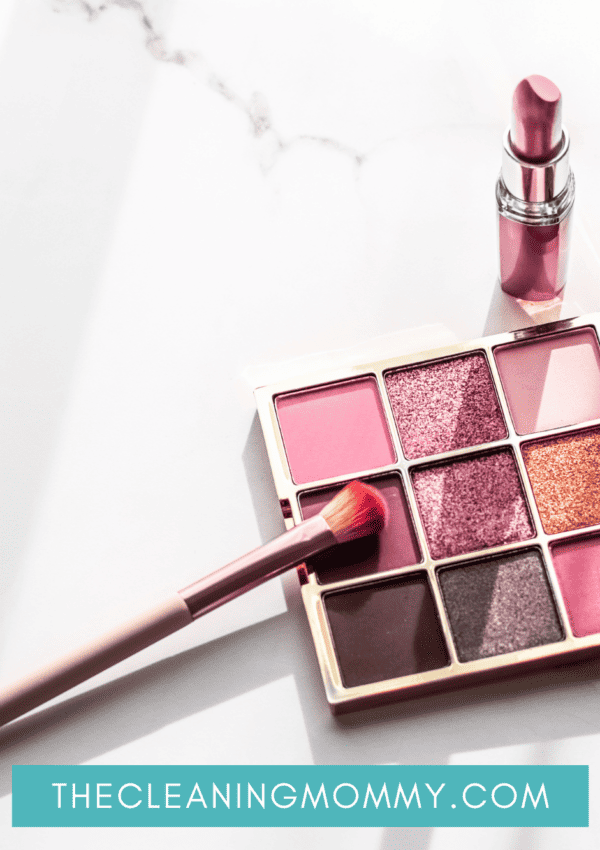
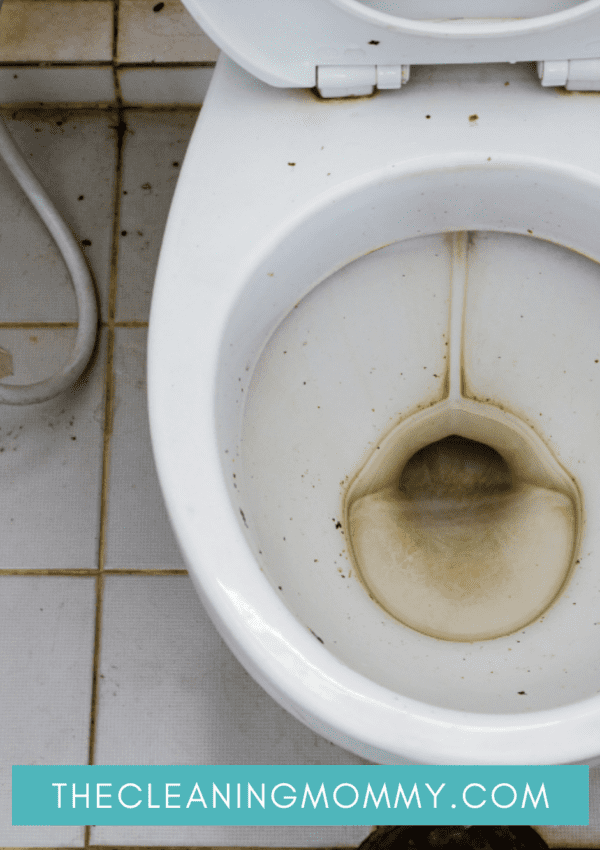
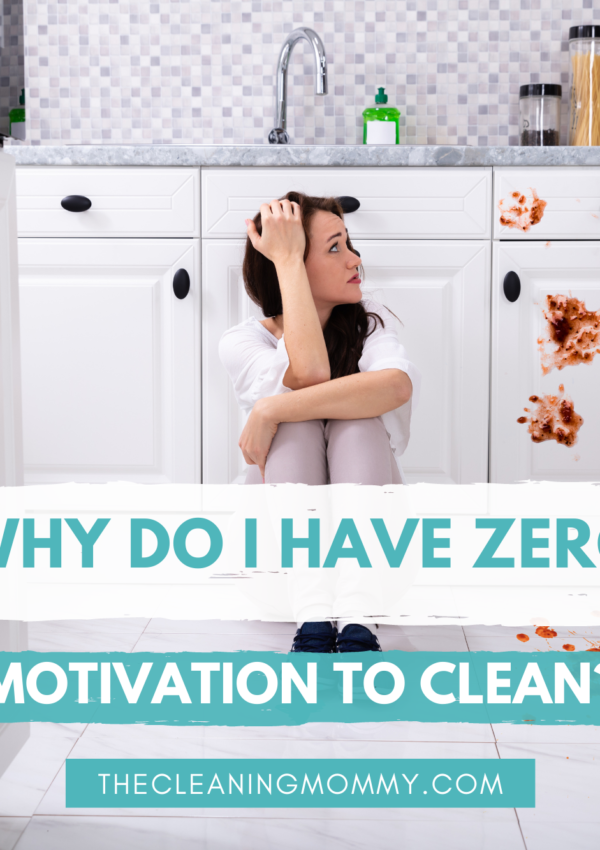
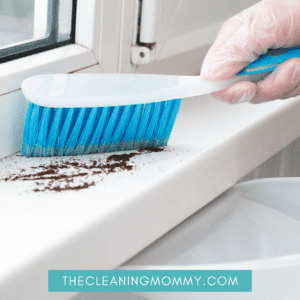
Leave a Reply